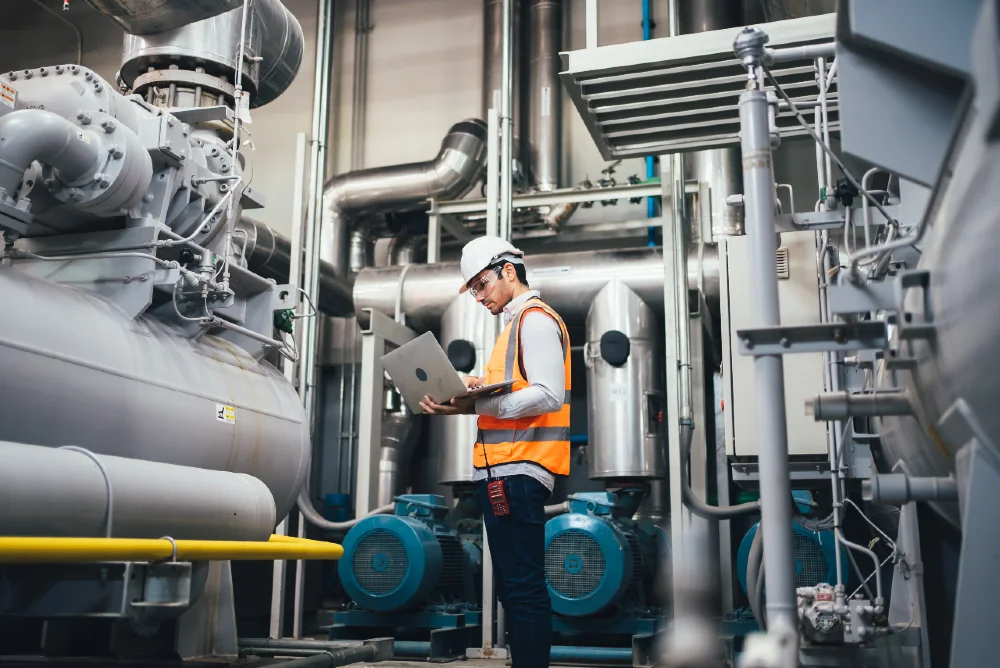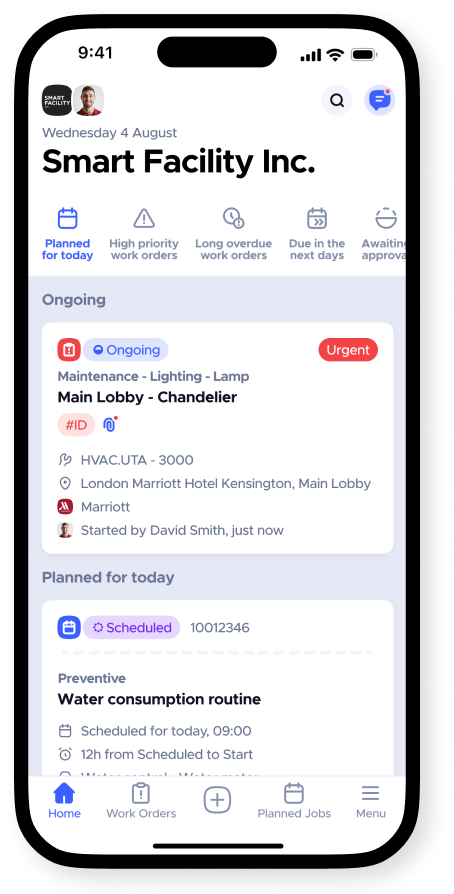7 min read
Table of contents
Module I - Innovation
Table of contents
Module I - Innovation
Why IMMPs are being chosen over CMMS
In the dynamic world of facility management, the quest for effective solutions is ongoing.
The pressure is on modern facilities to maintain uptime and streamline maintenance operations to avoid downtime. Unplanned downtime costs up to $50 billion annually across multiple industries.
The role of maintenance management in preventing downtime is well-established, with effective preventive maintenance bringing about reductions in costs and increases in productivity.
For a long time, Computerised Maintenance Management Systems (CMMS) set the benchmark for maintenance management, placing multiple maintenance organisation and control features into one piece of software.
But as businesses evolve, so do their needs. Cutting-edge solutions, such as Intelligent Maintenance Management Platforms (IMMPs), offer new opportunities for facility managers to improve the performance of their buildings and assets.


CMMS: the status quo
Computerised Maintenance Management Systems (CMMS) are a staple for managing maintenance tasks.
This specially designed software is a stalwart in the industry, built to assist facility managers in managing, coordinating, and tracking a wide array of maintenance tasks and work orders.
While CMMS is a significant improvement over not using any maintenance management software, new industrial pressures have fuelled the development of new tools.
For example, buildings and technology are more complex, customer and client expectations are increasing, and regulations regarding quality, safety, and sustainability are becoming increasingly stringent.
The limitations of ageing CMMS
CMMS software has been around for decades, and we’re starting to observe some limitations
Limited flexibility
CMMS solutions often provide limited customisation options, making it challenging for businesses to tailor the system to their specific needs.
Outdated technology
Compared to contemporary solutions like Intelligent Maintenance Management Platforms (IMMPs), CMMS technology can seem outdated.
Reactive instead of proactive
Complex interface
Some CMMS solutions might have a steep learning curve due to their complex interfaces, which can affect user adoption and efficiency.
Integration issues
Older CMMS solutions might not integrate smoothly with other systems or software, limiting data-sharing opportunities.
Scalability concerns
As a business grows and evolves, a CMMS might be unable to scale effectively to meet increasing maintenance management demands.
Inadequate analytics
While CMMS can record and store maintenance data, it often lacks robust analytics capabilities for insightful decision-making.
So, what if we could take the CMMS further? What if there was a way to match these impressive benefits and build on them?
That’s precisely what IMMPs can do.
IMMP and CMMS:
What are the differences?
An Intelligent Maintenance Management Platform differs from a CMMS in two ways:
1. Its “platform” status;
2. Its intelligence.
1. More than software, a platform
Intelligent Maintenance Management Platforms are platforms (surprise!) by design — they’re made to be a whole ecosystem of resources (software and hardware) to help maintenance managers streamline their operations with outstanding flexibility, intelligence and connectivity.
A CMMS’s functionality is given by its own set of features, which may be more or less appealing to you depending on the software and your operation. Meanwhile, an IMMP has the ability to connect and fully integrate with external tools and resources that your maintenance teams need to work in a simpler, more intelligent way.
Besides a multitude of native apps, an Intelligent Maintenance Management Platform can seamlessly integrate with external software — such as ERP, CRM, invoicing software and even custom software —, as well as hardware such as NFC tags, sensors, and all kinds of IoT.

2. Intelligence and automation
While the main value of a CMMS is to centralise information and manage tasks, an IMMP goes a few steps further. It leverages all that data to automate tasks and provide you with smart insights, time-saving predictions and suggestions.
Any time you connect a new app to your IMMP, the whole platform is enhanced. Previously connected apps gain new features so the whole system is fully integrated, and your existing records gain new information and new functionality.
This makes Intelligent Maintenance Management Platforms extremely flexible solutions, as they allow you to connect with whatever tools fit the needs of your team and your operation.
This also means that an IMMP can evolve with your business over time. For the next 10 years, you won’t need to jump to another solution because the complexity of your operations has increased, and you won’t have to lose whatever information you had recorded so far. Need more stuff? Simply connect more stuff and integrate some more.
The rise of Intelligent Maintenance Management Platforms
The rise of Intelligent Maintenance Management Platforms
Intelligent Maintenance Management Platforms (IMMPs) have evolved to alleviate the limitations of traditional CMMS. They provide facility managers with more tools and flexibility, but without overloading them with overcomplicated interfaces.
It’s important to highlight that IMMPs don’t overcomplicate the facility manager’s tech stack. On the contrary – users report that they’re easier to use, which is excellent for onboarding staff quickly and delegating tasks to non-IT professionals.
The IMMP edge
IMMPs effectively leverage advanced technologies such as AI and IoT.
This allows IMMPs to collect and analyse comprehensive maintenance and work order data, transforming it into valuable and actionable insights. Harness your data to cut costs and boost facility performance. Your clients and customers will thank you for it!
Some of the key features IMMPs include:
Dynamic and flexible interface
IMMPs operate as dynamic, real-time maintenance systems – a system of intelligence.
This means they are far more adaptable and responsive to changing operational needs compared to ageing CMMS. Moreover, you can use IMMPs to build your own optimised solutions – you’re not locked in to a clunky interface and bloated features.
Automation: streamlining maintenance tasks
IMMPs offer AI-powered features such as weekly alerts and automated failure reporting.
This not only lightens the workload for maintenance personnel, allowing them to concentrate on critical duties, but also significantly boosts productivity across maintenance operations.
Integration: bridging the gap between systems
One of the distinct advantages of IMMPs is their ability to seamlessly integrate with other digital tools and hardware systems.
This interoperability allows for improved data sharing and collaboration between different platforms.
An excellent example is integration with the accounting software Xero. Xero integration enables maintenance managers to automatically share invoices and procurement data with their accounting software.
Insightful analytics for data-driven decisions
IMMPs can generate automatic reports on buildings, utilities, work orders and maintenance.
This not only optimises maintenance planning and execution but also contributes to cost-efficiency and effective risk management. Use your data to cut costs and improve your facility’s performance.
The role of IMMPs across different sectors
IMMPs are game-changers across various industries, delivering an intelligent, integrative approach to maintenance management.
Crucially, they’re applicable to a wide range of industries and can be customised for multiple workflows. Let’s explore how IMMPs are reshaping operations across multiple sectors.
Retail
In retail environments, keeping assets working for clients and customers is crucial. Retail units feature a wide range of lifts, elevators, HVAC air conditioning units, lighting, etc, which all need to be kept in top condition. With an IMMP, all maintenance data is aggregated in a centralised system, providing valuable insights into asset performance, maintenance costs, and task completion rates. This empowers retail managers to make data-driven decisions that boost efficiency and reduce costs.
Facility services
In the world of facility services, managing many diverse assets across numerous buildings and possibly even different industries or sectors is typical. An IMMP simplifies this process through advanced features like automated work order creation and assignment, real-time asset tracking, and advanced reporting. IMMPs also ensure regulatory compliance through meticulous record-keeping and service level agreement (SLA) management.
Hospitality
The hospitality industry depends on smooth maintenance. IMMPs streamline maintenance processes, reducing the likelihood of asset failure and maintaining high levels of customer service. In addition, high maintenance standards are associated with better customer reviews and repeat business. Furthermore, IMMPs can integrate with other hotel systems, allowing for a holistic view of operations and quick resolution of issues.
Reporting and analytics
Infraspeak Gear provides valuable insights into equipment performance and maintenance activities through its reporting and analytics features. Asset and facility managers can use data to identify trends, evaluate the effectiveness of their maintenance strategies, and make data-driven decisions to optimise processes.
IMMPs for future-ready facility management
The pressure is on facilities to deliver ever-increasing uptime and maintenance performance.
IMMPs offer much-needed adaptability, combining easy-to-use interfaces with deep technical functionality. Critically, IMMPs are flexible and can be customised to users from different industries, including hospitality, retail, medical, manufacturing, and many more.
The future of facility management is here, and it’s intelligent, integrated, and efficient.
